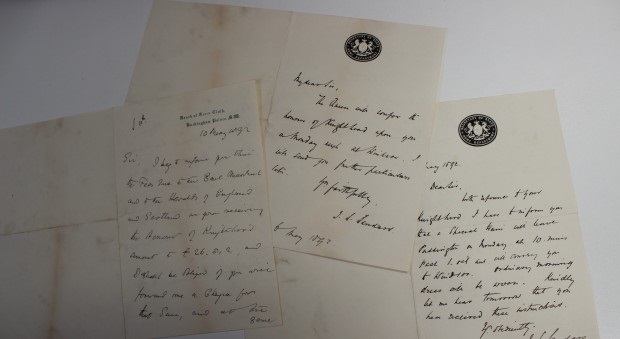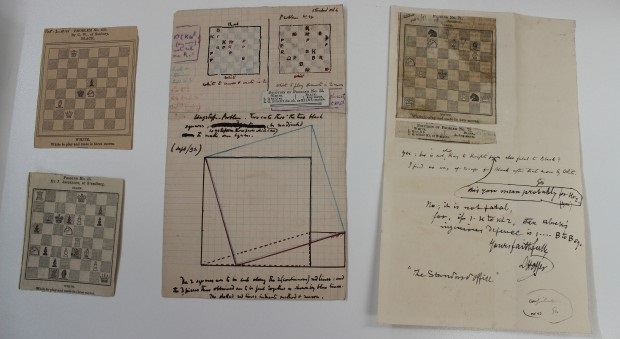The Royal College of Physicians was recently pleased to welcome Sophie Penniman as an archives intern. Sophie is studying English and history at Lawrence University in Appleton, Wisconsin, and spent 8 weeks here as part of a semester in the UK. In this post, Sophie writes about the personal papers of 19th-century physician George Buchanan.
While looking in the RCP archives for a project to work on, I came across an intriguing-looking black, leather-covered wooden strongbox. Inside was a jumble of papers spanning 20 years in the late 19th century. It turned out that these papers were from a Victorian doctor and epidemiologist named George Buchanan (1831–1895). They cover the latter part of Buchanan’s life, including his later career, retirement and death.

I think the thing that struck me the most while working on cataloguing this collection was the incredibly high regard Buchanan’s peers seemed to have for him. An editorial published in the Medical Press shortly after Buchanan’s retirement in 1892 claimed that 'no one has done more to expand and develop [public health administration and etiological science] than the late Medical Officer of the Local Government Board during his quarter of a century’s work' (MS5962/7).
When Buchanan’s co-workers discovered he would be retiring, at least 12 of them wrote him emotional letters expressing dismay that he would be leaving. His colleague F MacCabe wrote from his bed: ‘I am so very, very sorry for your retirement and I am perplexed at it. No one can wish you more heartily than I do every happiness in the future’ (MS5962/1).
George Buchanan was born in Islington, London, on 5 November 1831. He graduated from University College London with a BA degree in 1851 and then an MB in 1854. Buchanan originally entered private practice (including stints at the London Fever Hospital and Great Ormond Street Hospital) but soon public service came calling. In 1861, the privy council office requested that Buchanan become a medical inspector. By 1879, Buchanan had been appointed to the position of the medical officer to the local government board in Whitehall.

As part of his duties as medical officer, Buchanan spent a lot of time travelling around the country conducting investigations into how disease spreads. In a report he wrote around the time of his retirement, Buchanan recalls that he visited many different towns, studying the sanitary effects of everything from overcrowding at public schools to improper drainage (MS5962/4). At one point, while investigating water supplies to towns, Buchanan states that he even had to ‘ascertain the meaning of eels in the water-mains’.
One area in which Buchanan did a lot of research was vaccination, which at that time was still a relatively new field. He started in 1861, and his findings led in part to the Vaccination Act of 1867. During the London smallpox epidemic of 1881, Buchanan studied the mortality rates of children under the age of 10. He found that among the 55,000 children who had not been vaccinated, there were 782 deaths from smallpox, and among the 861,000 vaccinated children, only 125 had died from smallpox. Thus, Buchanan theorised, if all the children of London had been vaccinated, there would have been 134 total deaths, not 907. Conversely, if none of the children had been vaccinated, he concluded that the death toll would have been over 6,000 (MS5968/2).
At one point, while investigating water supplies to towns, Buchanan states that he even had to ‘ascertain the meaning of eels in the water-mains’.
Another contribution Buchanan made to the field of sanitation was through his research into the effect of soil dampness on the spread of disease. He found that wet soil provides a habitat outside the body for pathogenic bacteria, particularly those that spread tuberculosis.
In 1892, Buchanan was knighted by Queen Victoria for his contributions to public health. The RCP holds the correspondence Buchanan received about his knighthood ceremony (including instructions on what to wear and how to get to Windsor Castle). Following the knighthood, his colleagues at the local government board decided to recognise Buchanan’s service with a sum of cash. Buchanan used part of this to establish a medal in his name to be given to honour outstanding contributions to the field of public health. The first recipient of the medal, sweetly enough, was Buchanan's wife, Alice.

Besides its wealth of professional records, maybe the most intriguing part of Buchanan’s papers is his extensive collection of over 100 chess problems (MS5964). These puzzles, which are a bit like our modern Sudoku, were clipped by Buchanan from the newspaper for 3 years. You can see where he’s solved them, and he’s included the solution, along with the date and name of the paper, for almost every puzzle. There are even puzzles that Buchanan designed himself and, in a few cases, he and a friend (in different handwriting) write back and forth about the correct way of going about solving the puzzle. It shows a really interesting side to a prominent Victorian doctor that you wouldn’t necessarily get from just professional documents.

In all, this collection presents a wide-ranging, well-rounded view of an extremely interesting and influential physician. To explore them is to get a fascinating look into the life of a man who significantly contributed to our understanding of the spread of disease.
Sophie Penniman, archives intern
- George Buchanan’s personal papers are available to view by appointment in the RCP library reading room – please contact history@rcplondon.ac.uk.
Read our weekly library, archive and museum blog to learn more about the RCP’s collections, and follow @RCPmuseum on Twitter and @rcpmuseum on Instagram.
